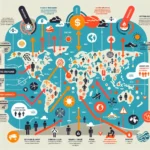Digital transformation in companies is a topic that has been gaining traction in recent IELTS Writing Task 2 exams. Given the rapid technological advancements and their impact on businesses, it’s highly likely that this theme will continue to appear in future tests. Let’s explore a relevant question that has appeared in past exams and could potentially resurface in various forms.
Some people think that in order to improve the quality of education, schools and universities should invest heavily in technology and digital resources. To what extent do you agree or disagree?
Analyzing the Question
This question directly relates to digital transformation in the educational sector, which is a subset of the broader topic of digital transformation in companies. The task requires you to express your opinion on whether substantial investment in technology and digital resources is necessary for improving educational quality.
Key points to consider:
- The focus is on schools and universities (educational institutions)
- The proposed action is heavy investment in technology and digital resources
- The goal is to improve the quality of education
- You need to state your level of agreement or disagreement
 modern classroom
modern classroom
Sample Essay (Band 8)
Here’s a sample essay that could potentially score a Band 8:
In today’s rapidly evolving digital landscape, the question of whether educational institutions should heavily invest in technology and digital resources to enhance the quality of education is a pertinent one. While I agree that technological integration can significantly benefit the learning process, I believe that a balanced approach, rather than heavy investment, is more appropriate.
Undoubtedly, incorporating technology into education can yield numerous advantages. Digital resources can provide students with access to a vast array of information, interactive learning experiences, and tools that cater to diverse learning styles. For instance, virtual reality applications can offer immersive historical or scientific simulations, enhancing students’ understanding and retention of complex concepts. Moreover, learning management systems can facilitate more efficient communication between educators and students, enabling personalized feedback and progress tracking.
However, it is crucial to recognize that technology should complement, not replace, traditional teaching methods. Excessive reliance on digital tools may inadvertently diminish essential skills such as critical thinking, face-to-face communication, and hands-on problem-solving. Furthermore, not all students have equal access to technology outside of educational institutions, potentially exacerbating existing socioeconomic disparities if education becomes overly dependent on digital resources.
A more balanced approach would involve strategic investments in technology where it can demonstrably enhance learning outcomes. This could include equipping classrooms with smart boards, providing students with access to online research databases, or incorporating coding and digital literacy into the curriculum. Simultaneously, institutions should continue to invest in teacher training, smaller class sizes, and diverse extracurricular activities, which are proven factors in improving educational quality.
In conclusion, while technology and digital resources have a valuable role to play in modern education, their implementation should be carefully considered and balanced with other educational priorities. By adopting a measured approach to digital integration, educational institutions can harness the benefits of technology without compromising the fundamental aspects of quality education.
(Word count: 295)
Sample Essay (Band 6-7)
Now, let’s look at a sample essay that might score in the Band 6-7 range:
In the modern world, technology is becoming more important in every aspect of life, including education. Some people believe that schools and universities should spend a lot of money on technology and digital resources to make education better. I partially agree with this idea.
There are several benefits to using technology in education. First, it can make learning more interesting for students. For example, using videos and interactive websites can help students understand difficult subjects more easily. Also, technology can give students access to more information than traditional textbooks. This can help them learn more about topics they are interested in.
However, there are also some problems with relying too much on technology in schools. One issue is that not all students have the same access to technology at home. This could create unfairness if too much schoolwork requires computers or the internet. Another problem is that some teachers might not know how to use new technology effectively, which could waste time and money.
I think the best solution is to find a balance between technology and traditional teaching methods. Schools should invest in some important technology, like computers and projectors in classrooms. But they should also spend money on other things that improve education, such as hiring good teachers and providing extra help for struggling students.
In conclusion, while technology can be useful in education, schools and universities should not spend all their money on it. A balanced approach that combines technology with other educational resources is likely to be more effective in improving the quality of education.
(Word count: 253)
Key Points to Note When Writing
-
Essay Structure: Both essays follow a clear structure with an introduction, body paragraphs, and a conclusion. The Band 8 essay demonstrates more sophisticated paragraph development and transitions.
-
Vocabulary: The Band 8 essay uses more advanced vocabulary (e.g., “pertinent,” “exacerbating,” “disparities”) compared to the Band 6-7 essay, which uses simpler terms.
-
Grammar: The Band 8 essay employs more complex sentence structures and a wider range of grammatical constructions. The Band 6-7 essay uses simpler, more straightforward sentences.
-
Task Response: Both essays address the question, but the Band 8 essay provides a more nuanced response with a clearer position and more developed arguments.
-
Coherence and Cohesion: The Band 8 essay demonstrates better paragraph and idea linkage, while the Band 6-7 essay is more basic in its organization.
Challenging Vocabulary to Remember
- Pertinent (adjective) /ˈpɜːrtɪnənt/ – relevant or applicable to a particular matter
- Exacerbate (verb) /ɪɡˈzæsərbeɪt/ – make (a problem, bad situation, or negative feeling) worse
- Disparities (noun) /dɪˈspærəti/ – a great difference
- Immersive (adjective) /ɪˈmɜːrsɪv/ – providing, involving, or characterized by deep absorption or immersion in something
- Inadvertently (adverb) /ˌɪnədˈvɜːrtəntli/ – without intention; accidentally
- Strategic (adjective) /strəˈtiːdʒɪk/ – relating to the identification of long-term or overall aims and interests and the means of achieving them
- Demonstrably (adverb) /dɪˈmɒnstrəbli/ – in a way that is clearly apparent or capable of being logically proved
In conclusion, the topic of digital transformation in education, as a subset of digital transformation in companies, is likely to remain relevant in IELTS Writing Task 2. Future questions might explore related themes such as the impact of artificial intelligence on job markets, the role of technology in workplace communication, or the challenges of data privacy in the digital age. To prepare effectively, practice writing essays on these topics, focusing on developing balanced arguments and using a range of vocabulary and grammatical structures. Feel free to share your practice essays in the comments section for feedback and further discussion.


